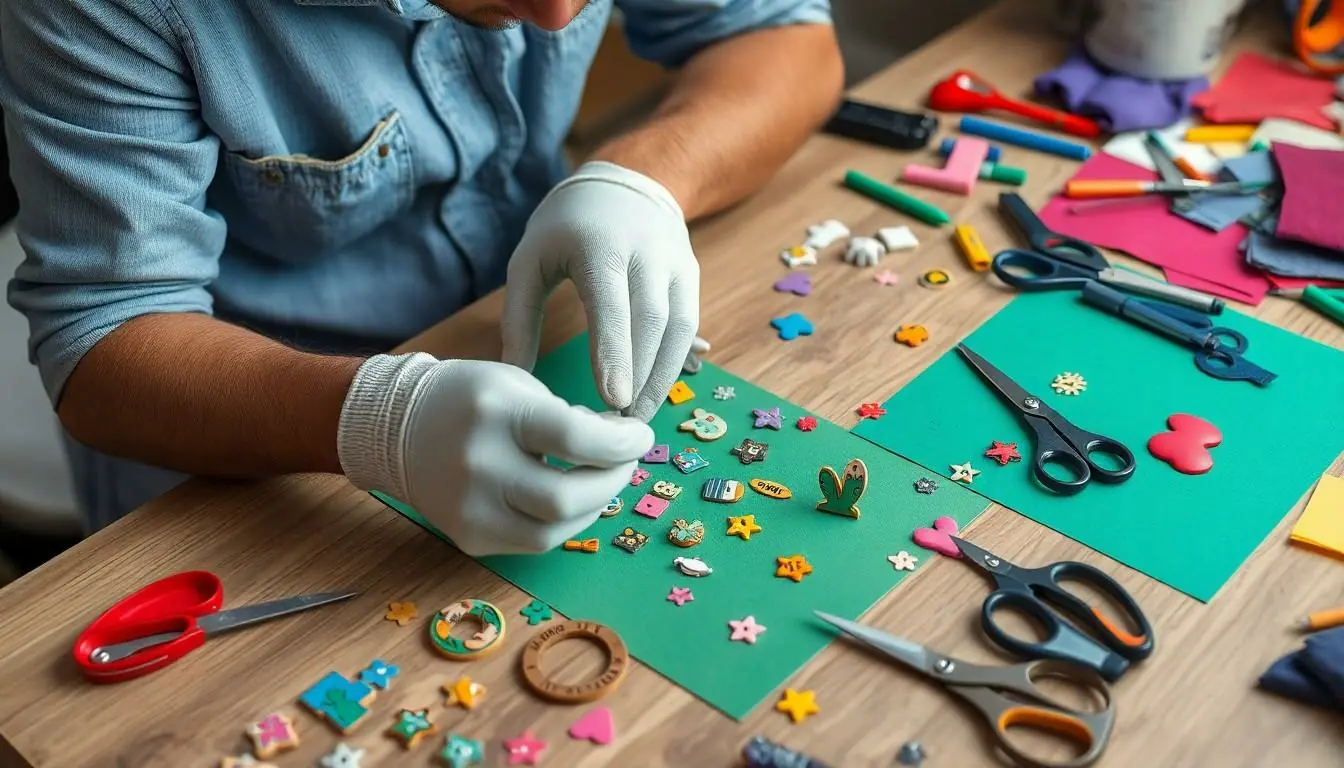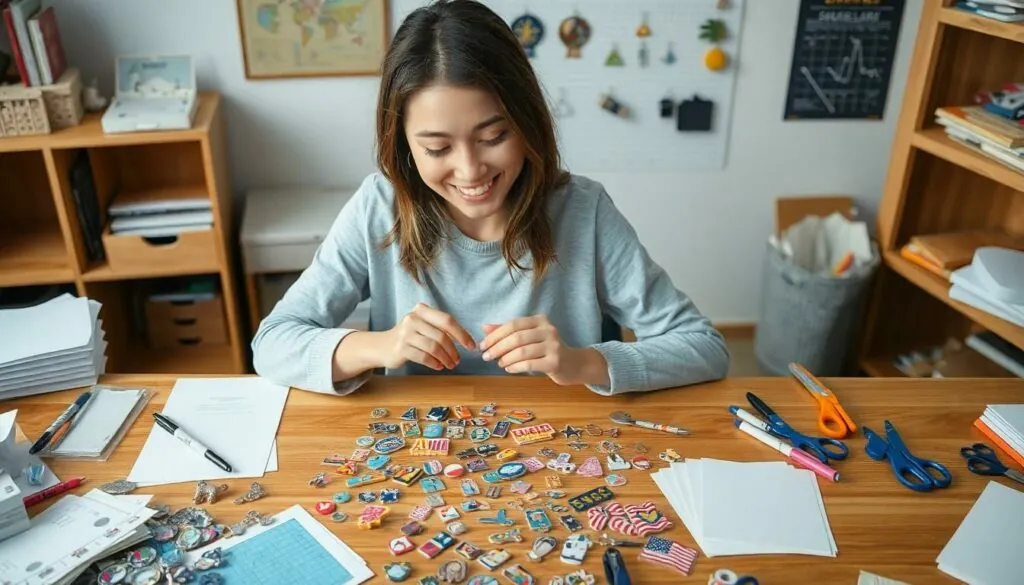Table of Contents
ToggleCrafting your own pins at home isn’t just a fun hobby; it’s a way to unleash your creativity and show off your personality. Imagine strutting around with unique pins that scream “look at me!” instead of settling for the same mass-produced designs everyone else has. Whether you’re aiming for quirky, elegant, or downright hilarious, making pins can be as satisfying as finding that last slice of pizza in the fridge.
Materials Needed
Creating pins at home requires specific materials to ensure successful crafting. Below are the essential supplies and optional tools to enhance the pin-making process.
Basic Supplies
- Pin backs: Choose various types like butterfly or military clutch for secure attachment.
- Material sheets: Utilize options such as felt, paper, or fabric to create unique designs.
- Adhesive: Use strong glue or a hot glue gun to bond materials reliably.
- Scissors: Select sharp ones for precise cuts and shaping of materials.
- Marker: Get a permanent or fabric marker to add details to the pin.
Each of these supplies plays a crucial role in achieving the desired design and functionality of the pins.
Optional Tools
- Craft knife: This provides cleaner cuts for more intricate designs.
- Ruler: A ruler offers measurement accuracy when laying out pin designs.
- Hole punch: Utilize a hole punch for creating small holes in designs, perfect for adding embellishments.
- Paint: Different paint types allow customization of surfaces for vibrant designs.
- Embossing tools: These can add texture and elevate the visual appeal of designs.
Incorporating these optional tools can enrich the creative process and enhance the overall outcome of pin-making projects.
Step-by-Step Guide

Making pins at home involves a series of straightforward steps. The following guide provides details for each part of the process.
Choosing a Design
Selecting a design serves as the first step in pin-making. Individual styles might include whimsical shapes, favorite quotes, or personalized logos. Inspiration can come from various sources, such as nature, art, or pop culture. Sketching ideas on paper can help visualize the final product. Consider the size of the pin based on the design, ensuring it fits well on the intended backing. Exploring popular themes can also spark creativity and make the process easier.
Preparing the Materials
Gathering materials is crucial for successful pin creation. Essential items include pin backs, adhesive, and your chosen material sheets. These sheets might consist of felt, wood, or plastic, depending on the desired look and feel. Keeping scissors and markers handy facilitates precise cutting and detailing. Optional tools, such as craft knives or embossing tools, might enhance texture and depth in the final design. Having everything organized ensures a smooth workflow and minimizes interruptions during the assembly process.
Assembling the Pin
Assembling the pin brings the design to life. Start by cutting the material according to the chosen design, ensuring clean edges. Apply adhesive to secure the pin backing to the crafted design. Placement of the pin backing matters; centering it allows for balanced use. Allow the glue to set according to the manufacturer’s instructions, ensuring durability. Additional embellishments like paint or glitter can enhance aesthetics if desired. This step finalizes the transformation from concept to a tangible piece of art.
Creative Ideas for Custom Pins
Custom pins allow for endless creativity, channeling individual styles and interests into tangible expressions. Explore various ideas that can enhance pin-making projects.
Themed Designs
Themed designs bring cohesion and focus to pin collections. Nature-inspired motifs, such as flowers or animals, resonate with outdoor enthusiasts. Retro themes, featuring 80s or 90s elements, appeal to nostalgia lovers. Pop culture references, including favorite movies or music, engage fans effectively. Seasonal themes, like winter holidays or summer vacations, offer exciting ways to celebrate the year. By choosing a specific theme, individuals can create a set of pins that tell a cohesive story and showcase personal preferences.
Personalized Touches
Adding personalized touches makes each pin unique. Custom names or initials can enhance designs, making them meaningful gifts. Incorporating favorite quotes resonates deeply with the creator’s beliefs or humor. Using favorite colors showcases individual taste while ensuring each pin stands out. Personal photographs can transform pins into cherished mementos, capturing special moments. A dash of creativity in personalization can elevate ordinary pins into treasured pieces of art.
Tips for Successful Pin Making
Successful pin making requires attention to detail and creativity. Following a few guidelines helps ensure a satisfying crafting experience.
Common Mistakes to Avoid
Forgetting to measure dimensions may lead to oversized or undersized pins. Using inappropriate adhesives can cause pins to fall apart quickly. It’s vital to choose materials that resist wear and tear, preventing rapid deterioration. Ignoring drying times often results in smudged designs. Overloading embellishments can detract from the overall look, making the pin appear cluttered. Remember to double-check the alignment of pin backs to avoid uneven application. Skipping the sketching phase can lead to unclear designs, resulting in less satisfying outcomes.
Best Practices for Durability
Selecting high-quality materials plays a significant role in pin longevity. Use strong adhesives designed for crafting, which create lasting bonds. Applying protective coatings safeguards designs against wear from daily use. Choosing resin or sealing options can add an extra barrier against damage. Storing pins properly in a padded case prevents scratches and other surface damage. Reinforcing pin backs with additional glue ensures long-term attachment. Regularly inspecting completed pins helps identify wear early, allowing for timely repairs.
Creating pins at home is a rewarding and fulfilling endeavor that allows for personal expression and creativity. By following the steps outlined in the article, anyone can craft unique pieces that reflect their individual style. The process not only fosters artistic skills but also results in one-of-a-kind accessories that stand out in a crowd.
With the right materials and a bit of imagination, the possibilities are endless. Whether designing themed collections or adding personal touches, each pin can tell a story. Embracing this craft not only leads to beautiful creations but also offers a satisfying way to showcase personality and interests. So gather those materials and let creativity shine through in every pin made.




